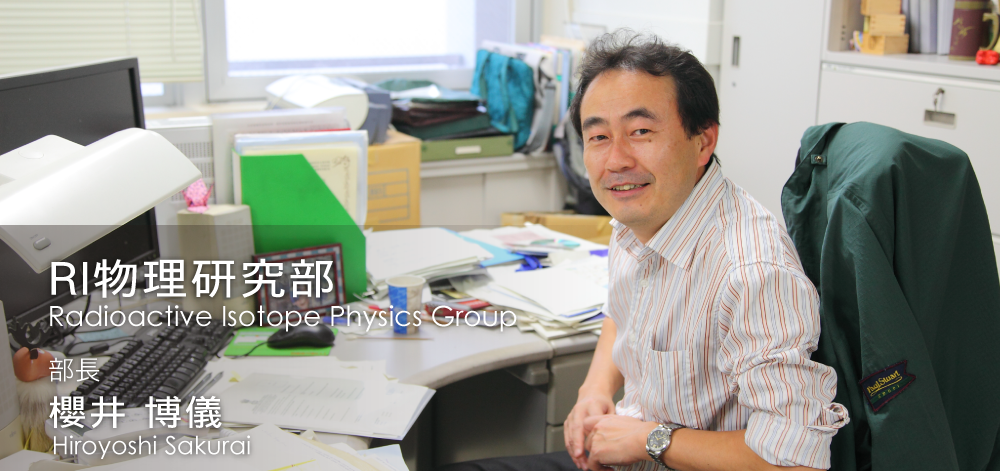Research Facility Development Division
- Accelerator Group
- Accelerator R&D Team
- Ion Source Team
- RILAC Team
- Cyclotron Team
- Beam Dynamics & Diagnostics Team
- Cryogenic Technology Team
- Infrastructure Management Team
- Research Instruments Group
- Automated Operation Technology Team
- BigRIPS Team
- SAMURAI Team
- Data System Team
- Detector Team
- Instrumentation Development Group
Nuclear Science Research Division
- Radioactive Isotope Physics Group
- Nuclear Dynamics Research Group
- Few-body Systems in Physics Laboratory
- Cosmic Radiation Laboratory
- Astro-Glaciology Research Unit
- Nuclear Many-body Theory Laboratory
- RHIC Physics Research Group
- Three-Body Nuclear Force Laboratory
- Meson Science RIKEN ECL Research Team
Accelerator Applications Research Division
Directly under the Nishina Center
Closed Laboratory
Radioactive Isotope Physics Group

- Now writing...
Research Areas
This laboratory explores exotic nuclear structures and dynamics in unstable nuclei that have never been investigated before, such as those with largely imbalanced proton and neutron numbers. Our aim is to develop new experimental techniques utilizing fast RI beams to discover new phenomena and properties in unstable nuclei. Another important subject is the equation-of-state of asymmetric nuclear matter, and its association with the origin of elements and with neutron stars. For instance, we are making attempts to the better understand underlyning mechanism for exotic stability-enhancements of very neutron-rich fluorine isotopes, the large deformation of the nucleus 34Mg with N=22 in spite of its vicinity to the N=20 magic neutron number and anomalous collectivity in 16C. We are further extending these studies to medium- and heavy-mass regions by developing facilities, detectors and unique methods at RIBF, thereby leading on the challenging task to find new exotic phenomena. We also perform numerical simulations of nucleosynthesis under the environment of core-collapse supernovae, and moreover quest for footprints of supernovae and solar activities in the past, embedded in Antarctic ice core, in collaboration with Cosmic radiation laboratory and National Institute of Polar Research.
Research Subject
- Study of structure and dynamics of unstable nuclei through development of new methods utilizing fast RI beamsI beams
- Stability of exotic nuclei and exploration into limit of nuclear existence
- Research on equation-of-state in asymmetric nuclear matter via heavy-ion induced reaction
- Promotion of nuclear astrophysics in an interdisciplinary organization
List of Selected Publications
- Wang H., Otsu H., Sakurai H., et al.:
"Spallation reaction study for fission products in nuclear waste: Cross section measurements for Cs-137 and Sr-90 on proton and deuteron"
Phys. Lett. B 754, 104-108 (2016)
- Shane R., McIntosh A.B., Isobe T., et al.:
"S pi RIT: A time-projection chamber for symmetry-energy studies"
Nucl. Instrum. Methods A 784, 513-517 (2015)
- Lorusso G., Nishimura S., et al:
"beta-Decay Half-Lives of 110 Neutron-Rich Nuclei across the N=82 Shell Gap: Implications for the Mechanism and Universality of the Astrophysical r Process"
Phys. Rev. Lett. 114, 192501 (2015)
- Steppenbeck D., et al.
"Evidence for a new nuclear 'magic number' from the level structure of Ca-54"
Nature 502, 207 (2013)
- Nishimura S., Li Z, Watanabe H., Yoshinaga K, et al.:
"Beta-Decay Half-Lives of Very Neutron-Rich Kr to Tc Isotopes on the Boundary of the r-Process Path: An Indication of Fast r-Matter Flow"
Phys. Rev. Lett. 106, 052502 (2011)
- Doornenbal P, Scheit H, Aoi N, Takeuchi S, et al.:
"Spectroscopy of Ne-32 and the "Island of Inversion""
Phys. Rev. Lett. 103, 152503 (2009)
- Suzuki D., Iwasaki H., Otsu H., et al.:
"Breakdown of the Z=8 Shell Closure in Unbound O-12 and its Mirror Symmetry"
Phys. Rev. Lett. 103, 152503 (2009)
- Ong, H. J., Imai, N., Suzuki D., Iwasaki H., Sakurai H., Onishi T.K., Suzuki M.K., Ota S., Takeuchi S., Nakao T., et al.:
"Lifetime measurements of first excited states in C-16, C-18"
Physical Review C 78, 014308 (2008)
- Yoneda K., Sakurai H. et al.:
"Deformation of 34Mg studied via in-beam -ray spectroscopy using RI beam fragmentation"
Physics Letters B 499, 233-237 (2001).
- Sakurai, H., Lukyanov, S.M., Notani, M., Aoi, N., Beaumel, D., Fukuda, N., Hirai, M., Ideguchi, E., Imai, N., Ishihara, M., Iwasaki, H., Kubo, T., Kusaka, K., Kumagai, H., Nakamura, T., Ogawa, H., Penionzhkevich, Yu.E., Teranishi, T., Watanabe, Y.X., Yone.:
"Evidence for particle stability of 31F and particle instability of 25N and 28O"
Physics Letters B 448, 180-184 (1999).




